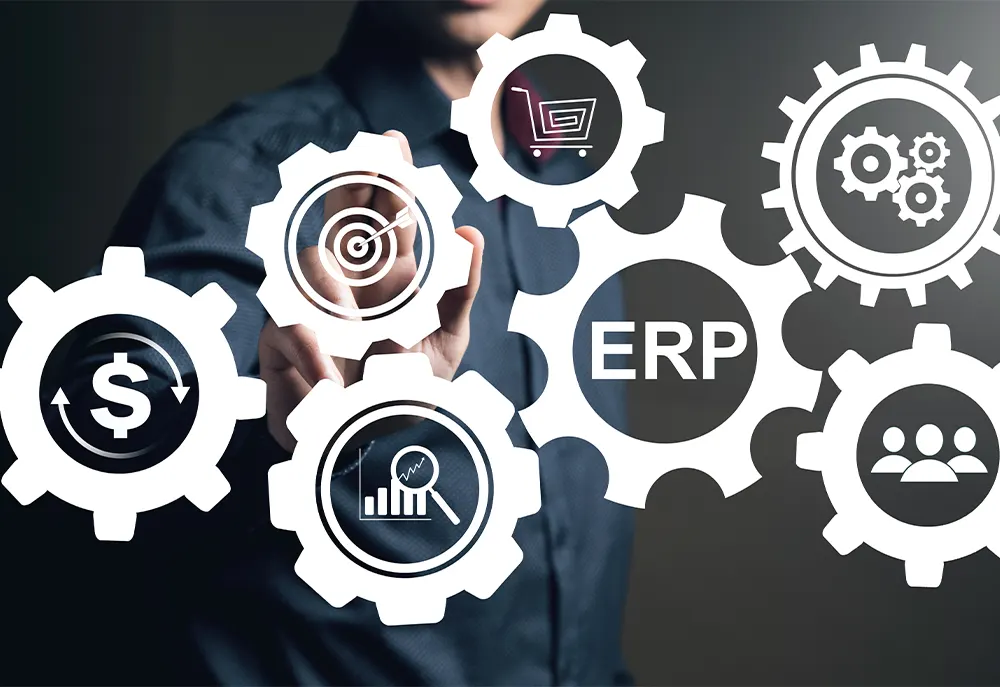Integrating an ERP and E-commerce solution is an increasingly popular strategic move for businesses. Companies often seek to optimize operational management while maximizing lead acquisition. By combining the features of an ERP (Enterprise Resource Planning) system with an e-commerce platform, this solution enables:
- Centralized and automated data collection,
- Inventory management,
- Order tracking,
- Customer behavior analysis.
This centralization of information streamlines processes and provides customers with a more personalized shopping experience.
The synergy between ERP and e-commerce solutions allows real-time tracking of each stage of the purchase journey. Consequently, businesses can anticipate customer expectations and tailor their offerings accordingly. For instance, by analyzing the most viewed products or items left in carts, the ERP can trigger targeted marketing actions to encourage visitors to complete their purchases. Additionally, improved visibility into stock levels and delivery times reduces the risk of stockouts. This dual benefit enhances customer satisfaction and boosts conversions.
This integration not only offers operational benefits but also serves as a powerful lever for capturing and converting leads. By making the purchasing process smoother and more personalized, it fosters a customer experience that builds loyalty and drives conversions.
This article explores the tangible advantages of integrating ERP and e-commerce solutions. We will describe best integration practices to capture leads while standing out from the competition.
ERP and E-commerce: Pillars of a Lead Acquisition Strategy
The integration of ERP and e-commerce solutions transcends mere internal process optimization. It is a true growth driver for businesses. In a digital landscape where consumer expectations are constantly evolving, businesses must be agile and deliver a seamless, personalized customer experience.
An ERP system connected to an e-commerce platform centralizes all key business data, from customer information to inventory and order management. This centralized data enhances marketing visibility and consistency, transforming every customer interaction into an opportunity for conversion.
This section will detail why this solution is fundamental for capturing leads and retaining customers in an increasingly competitive environment.
Benefits of an ERP
An ERP system is more than just a data management tool. It centralizes all company information, including inventory, customer data, accounting, and even human resources. This real-time overview facilitates decision-making and optimizes operations.
An ERP can track customer purchasing behavior, analyze popular products, and highlight peak demand periods. For e-commerce sites, such insights are critical for anticipating trends, adapting marketing strategies, and maximizing conversions.
Benefits of E-commerce
E-commerce serves as the company’s storefront on the web. With a robust e-commerce platform, businesses can attract, engage, and convert visitors into customers. These platforms are designed to optimize the user experience (UX) through features such as personalized product recommendations, customer reviews, and simplified navigation.
However, to maximize lead capture, e-commerce must be backed by a strong data foundation. This is where an ERP system comes into play to boost your e-commerce strategy.
Why Combine ERP and E-commerce solution ?
Integrating an ERP with an e-commerce platform is key to synchronized, real-time management. Stock levels are automatically updated, customer information is shared across systems, and teams can track every lead from initial contact to conversion.
Centralizing this information helps to:
- Improve customer satisfaction,
- Optimize delivery times,
- Offer tailored solutions to lead-specific needs.
How to Choose the Best ERP Solution for Your E-commerce Business
With a multitude of ERP solutions on the market, selecting one that meets your specific needs is crucial. An ERP for e-commerce should adapt to particular activities such as inventory management, customer data processing, or logistics tracking.
Choosing the right ERP requires a needs analysis, feature evaluation, and consideration of customization options.
Optimizing Lead Generation with Integrated Processes
Integrating an ERP with an e-commerce platform offers undeniable advantages for lead generation and customer satisfaction. Today’s consumers seek smooth, transparent, and personalized shopping experiences. A combined ERP and e-commerce solution provides immediate responses to demands while enabling precise stock management and shorter delivery times.
This operational efficiency, coupled with in-depth customer insights, allows businesses to:
- Stand out from the competition,
- Build customer loyalty,
- Convert visitors into buyers.
Automating Customer Interactions
With an integrated ERP, all customer interactions (from contact information to purchase preferences) are centralized and easily accessible. For example, when a prospect subscribes to an e-commerce site’s newsletter, the ERP can automatically send personalized offers.
Additionally, CRM tools within the ERP enable sales teams to track each prospect’s interaction history. This allows tailored solutions for each individual, reducing manual tasks and improving sales efficiency. This automation increases the likelihood of converting leads into customers, driving business growth.
Personalizing Offers
Centralized data enables personalized recommendations and offers based on actionable insights such as purchasing behavior and interactions between leads and the brand. For example, if a lead frequently views a specific product category, the system can trigger a personalized email campaign encouraging a purchase.
This personalization is vital for capturing and retaining prospects’ attention, offering a unique experience that ultimately boosts conversion rates.
Data Tracking and Analysis
With ERP and e-commerce solutions, businesses can analyze site performance and marketing campaigns in detail. Key performance indicators (KPIs) such as conversion rates, average order value, and click-through rates on personalized offers are readily available.
These insights help businesses fine-tune their lead generation strategies to maximize marketing efficiency.
Essential ERP Features for E-commerce
The strength of combining ERP and e-commerce solutions lies in their advanced features. These capabilities streamline online store management, enhance operational efficiency, and improve stock tracking and customer behavior analysis.
Real-Time Inventory Management
Automatic, real-time inventory updates ensure product availability at the time of purchase. This reduces the risk of unfulfilled orders, enhances customer satisfaction, and fosters loyalty.
Order Tracking and Logistics
An ERP and e-commerce solution streamlines end-to-end order tracking. Orders are automatically processed and shipped, minimizing lead times. Customers can monitor their orders in real time, a feature highly valued in e-commerce.
Performance Analytics Tools
Integrated analytics tools track product, campaign, and customer interaction performance. This allows businesses to identify profitable products and adjust strategies accordingly.
Conclusion: A Unified Approach to Boost Lead Acquisition and Customer Satisfaction
Integrating ERP and e-commerce solutions is not merely a technological choice but a lead acquisition and customer retention strategy. By centralizing data, automating processes, and optimizing interactions, businesses can deliver a seamless, personalized customer experience.
Companies adopting such solutions benefit from enhanced resource management, stronger customer loyalty, and higher lead conversion rates. To implement this integration effectively, it is advisable to consult experts in ERP and e-commerce solutions who can guide businesses in selecting and implementing the right tools.
Ultimately, this approach ensures better resource management, improved customer retention, and a significant boost in lead conversion rates.






